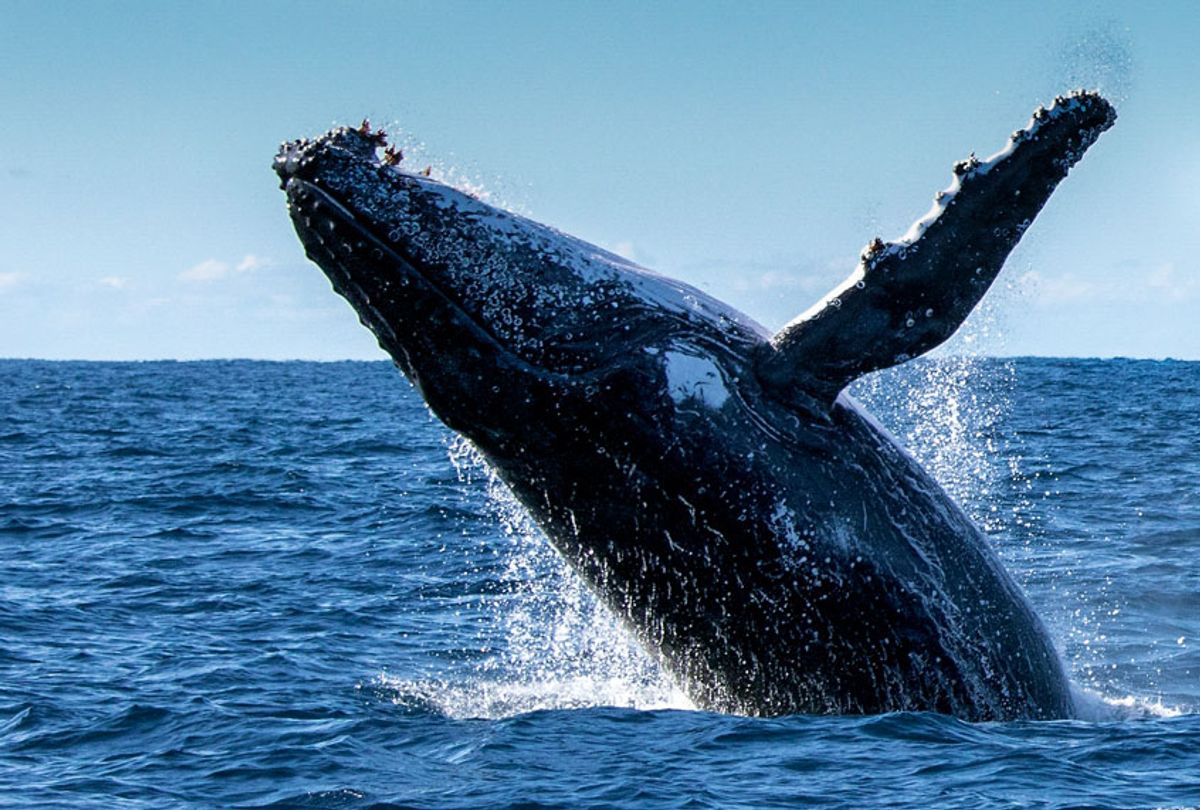Tragic photos of oil-soaked sea animals solidified in the public consciousness the notion that oil drilling and shipping were one of the major pollutive threat to sea life. Yet a new study suggests that plastic pollution may be far worse, especially for whales.
A team of researchers at Hampden-Sydney College in Virginia published a paper in The Royal Society Open Science journal on the effects of petroleum-based hydrocarbon oils (read: plastics) on the baleen of a whale. Baleen is a unique keratinous oral tissue, made up of the same protein in human fingernails, that can be found on the jaws of large whales. The eponymous Baleen whales, a class of whale that includes humpback whales and gray whales, use their baleen plates to separate food from the water when they are skim-feeding.
Considering oil has historically posed great risks to baleen whales — as it can irritate eyes, skin, and increase risk of infection when ingested — the likelihood of it impacting a whale’s baleen structure seemed high. But to the researchers' surprise, it was not.
“Oils of different weights and viscosities were tested, including six petroleum-based oils and two fish or plankton oils of common whale prey,” the authors wrote. “No notable differences were found by oil type or whale species.”
Instead of absorbing the oil, it rinsed off by flowing water, the study states, which focused on the baleen of four different whale species: bowhead, fin, humpback whales, and the North Atlantic right whales, which are severely endangered. The baleen, according to the study, either came from subsistence hunters or whales who died naturally, and was immersed in various oils tested, some for seven days.
“Microscopic examination shows minimal wrinkling or peeling of baleen's cortical keratin layers, probably due to oil repelling infiltrated water,” the authors stated. “Combined results cast doubt on fears of baleen fouling by oil; filter porosity is not appreciably affected, but oil ingestion risks remain.”
Researchers stated baleen whales likely face a greater danger from plastic pollution.
“We conclude that ingestion of microplastics may pose a greater risk to whales than ingestion of oil,” the researchers stated. “This conclusion is based on our findings of poor adsorption of oil to baleen, whereas we found (from our particle capture experiments) that the baleen filter is highly effective in trapping and accumulating small plastic particles, such that plastic is both more likely to clog the baleen filter and also perhaps more likely to be ingested by whales than oil.”
This study is timely considering the rising numbers of whales dying across the world due to plastic consumption. Marine animals often ingest plastic waste because they mistake it for food. Once a whale has ingested the plastic, it can’t be metabolized or broken down. This can cause them to become sick because of the buildup in the stomach. In this case, the whale will stop eating and ultimately starve to death. Just last week a sperm whale washed up on the shore in Italy with a stomach full of plastic. Likewise, microscopic plastic particles — known as microplastics — outnumber zooplankton in some parts of the ocean.
The study is not meant to suggest oil drilling and spills are not a threat to marine life, but to merely put into perspective the plastic problem in the world's oceans.
“Combined results cast doubt on fears of baleen fouling by oil; filter porosity is not appreciably affected, but oil ingestion risks remain,” the researchers emphasized. “Particle capture studies suggest potentially greater danger to mysticetes [Baleen whales] from plastic pollution than oil.”
More than 8.8 million tons of plastic end up in the oceans each year, according to the World Wildlife Fund. Since the 1950s, annual production of plastics has increased by nearly 200-fold. An estimated 80 percent of ocean plastics come from land-based sources, and 20 percent from marine sources, according to the nonprofit Our World in Data. If this pace continues, one report published in Science Advances estimates by 2050 the world will have produced 26 billion metric tons of plastic waste. Half of that will be dumped in landfills, and the other half becomes pollution in the environment.
Wellsley Brown, a plastics campaign associate at Oceana, told Salon in April there is a likely connection between the rise in plastic production and whale deaths.
“It makes sense that unfortunately, just because more plastic is going into the ocean, more whales are eating and dying from it,” Brown said. “We are living in a single-use plastic society where companies are wrapping so many of their products in single-use plastics, and plastic production has outpaced waste management's ability to keep up.”



Shares